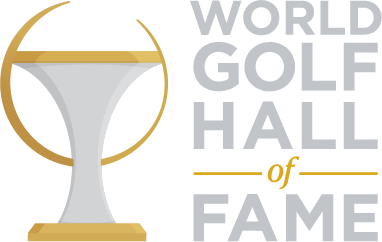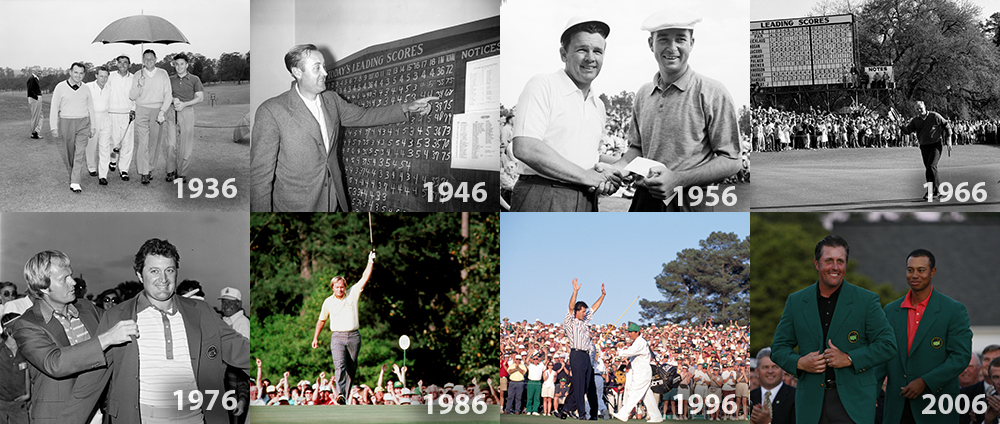By Dr. Tony Parker, World Golf Hall of Fame & Museum Historian
The Masters Tournament, held annually at Augusta National Golf Club, has been the scene of some of the most exciting finishes in the history of the game. Whether it has been a tremendous come-from-behind victory (Jack Nicklaus, 1986) or a magical final round (Phil Mickelson, 2006), there is never a dull moment during Masters Week.
The World Golf Hall of Fame takes a look back at some of these memorable events by the decade, beginning in 1936.
1936
The first Masters Tournament was held in 1934 with Hall of Fame Member Horton Smith winning the inaugural event. Going into the third Masters, he felt his chances were good to take his second tournament title. Smith, a dominant player having come into the Masters with 22 previous wins, knew the course and loved it.
With rain delays and the final two rounds pushed back to Monday, it was anyone’s game. Entering the final round, Smith found himself three shots back to “Lighthorse” Harry Cooper. While Cooper struggled during the final round, Smith hit his stride on the back nine. On the 14th hole he chipped in from 50 feet for a birdie and followed that with another birdie on 15 to take the lead.
Cooper ended the day with a round of 76 and a final score of 286, while Smith held on for a one-stroke victory to reclaim his second Masters title.
1946
Byron Nelson won the Masters tournament in 1942 before World War II intervened. The Masters was not held during 1943 to 1945. The 1946 Masters was the first since the end of the war, and the field was full of returning veterans and others who played limited schedules during the war.
Nelson was in the field as were fellow Hall of Fame Members Sam Snead, Ben Hogan, Jimmy Demaret, Lloyd Mangrum and a host of previous Major Championship winners. Hogan was still looking for his first Major win and was playing well.
However, after 3 rounds it would be a relatively unknown player at the top. His name was Herman Keiser and he had just returned from three years in the Navy.
Keiser went into the final round five shots up, but wasn’t able to maintain the pace as Hogan made a charge. Playing two groups behind Keiser, Hogan pulled to within one shot. Keiser 3-putted the 18th to drop back into a tie with Hogan. Hogan needed a birdie to win or a par to force a playoff on the 18th hole; however, he missed his two-foot par putt and gave the victory to Keiser. It would be Keiser’s only Major Championship victory.
1956
The 1956 Masters Tournament is a story of “almost.” An amateur has never won the Masters, but this was the closest opportunity brought down to the final stages.
Amateur Ken Venturi went into the final round with a commanding four-stroke lead over Cary Middlecoff. Venturi opened the tournament with a blistering 66 followed by another low-round-of-the-day 69. He struggled with the weather during Saturday’s round with a 75 but didn’t lose any ground.
Going into Sunday, the playing conditions were tough with strong winds battering the course. Only two players broke par in the final round – Jack Burke, Jr. and Sam Snead. Burke started the day eight shots behind Venturi. While Burke beat the weather with a score of 71, Venturi faltered to a final round 80. The nine-stroke difference was enough for Burke to take a one-shot victory over Venturi.
Covering an eight-stroke deficit to win the Masters still is the largest come-from-behind victory in Masters history.
1966
Jack Nicklaus came to the 1966 Masters as the reigning champion. Thus far in the history of the Masters, no one had won back-to-back. Nicklaus was the favorite coming into the tournament, having previously won four Major Championships including two Masters.
However, this Masters would not be the year of explosive charges and miraculous golf shots. He went into the final round tied for the lead with Tommy Jacobs, only two shots ahead of Gay Brewer and Arnold Palmer. The day was sporadic for each of the players with Brewer playing the better of the four.
Brewer caught Nicklaus, and Jacobs took a one-shot lead heading to the 18th. However, Jacobs made a bogey on the hole and dropped back to finish regulation play in a three-way tie.
In the 18-hole playoff on Monday, Brewer dropped back quickly and never recovered while Jacobs dropped a shot at the 10th hole and Nicklaus birdied the 11th. That was enough for Nicklaus to take the title.
This was Nicklaus’ third Green Jacket and first repeat win. In an unusual move, Nicklaus put the jacket on himself as the reigning champion.
1976
The 1976 Masters Tournament was dominated by a new-and-improved Raymond Floyd. Floyd came to the Masters that year as a new man. He met and married his wife Maria in 1974, and now had two young sons. Additionally, he was coming to Augusta brimming with confidence. Just two weeks before the Masters, Floyd shot a final round 66 at the Greater Greensboro Open. He told his father, “I’m going to win the Masters,” and did just that.
He started the Masters with blistering rounds of 65 and 66. After day two, Floyd’s closest competitor was Jack Nicklaus, five strokes back. After Saturday’s round of 70, Floyd found himself eight shots up.
One club that helped Floyd was his use of a 5-wood instead of his traditional 1-iron. On the par-5 holes alone he was 14-under par. His final round of 70, 17-under-par, tied Nicklaus’ scoring record of 271 and gave him his first Masters win. Floyd finished eight strokes over Ben Crenshaw, who had the low round of the day with a 67.
1986
The final round of the 1986 Masters in Augusta has been hailed as the most exciting and greatest finish in the history of the tournament. All of the greats were at the top of the leader board and it promised to be a fight to the very end. Jack Nicklaus was five strokes back and no one expected him, at age 46, to be a contender. One sports commentator wrote that Nicklaus was “done.”
At the start of Sunday’s round, Bernhard Langer and Greg Norman were tied at the top at 6-under-par; Seve Ballesteros was one stroke back. The lead would change six times throughout the day.
Nicklaus started his amazing charge with three straight birdies on holes 9, 10 and 11. He then birdied the 13th. When Nicklaus eagled the 15th hole, the crowds erupted with cheers heard across the golf course. He followed that with a birdie at the par-3 16th, nearly a hole-in-one. On the 17th hole, Nicklaus dropped an 18-foot putt for another birdie. His putt hit the center of the cup and put him one shot in the lead. He parred the 18th and went into the clubhouse as the leader.
Tom Kite and Greg Norman both had the chance to tie or beat Nicklaus, but both faltered on the 18th hole. Nicklaus won his sixth Masters and 18th Major Championship title. It would be his last of each.
1996
Though Nick Faldo won his third Green Jacket at the 1996 Masters, the tournament will always be remembered as the one Greg Norman let slip away.
Greg Norman started the tournament with a record-tying score of 63. He followed the next two days with solid rounds of 69 and 71 to give him a 6-stroke lead going into the final round over Nick Faldo.
Although Faldo played outstanding golf, coming in with the low-round-of-the-day with a score of 67, it was Norman’s final round 78 that gave Faldo his five-shot victory – a swing of 11 shots. Norman recorded five bogeys and two double-bogeys.
This marked Nick Faldo’s sixth and final Major Championship.
2006
Phil Mickelson came to the 2006 Masters looking for his third Major in three years. There would be no great fireworks but solid golf all week. Mickelson was not known to be a consistent player but rather a risk-taker; however, that week he settled into steady play.
He opened the tournament with a score of 70, three strokes behind the first round leader, Vijay Singh. On day two, he came in with a par-72 round and found himself four shots out of the lead. However, day three saw the leaders begin to drop away while Mickelson held steady and shot one of the best rounds of the day with a score of 70 to put him one shot in the lead.
The final round was the best round of Mickelson’s Masters. His touch around the greens and his putting brought him in with a round of 69, despite a bogey on the 18th, up by two strokes over Tim Clark. Mickelson had his second Green Jacket.
2016
On the 55th anniversary of Gary Player becoming the first international player to win the Masters, another international player – Englishman Danny Willett – stakes his claim for the Masters title. Congratulations, Danny!


